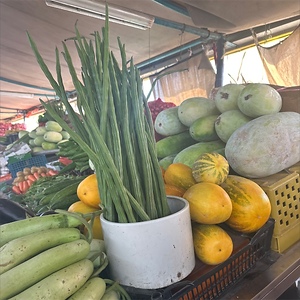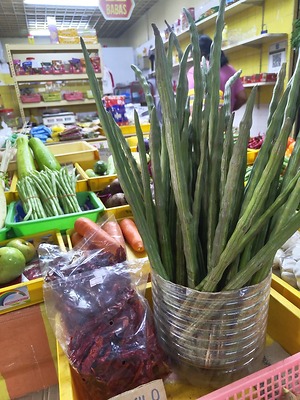


Drumstick Moringa
Estimated Inventory, lb : 0
Description/Taste
Drumstick pods are long and slender, averaging 20 to 45 centimeters in length, and are generally straight to cylindrical in shape with tapered ends. Each pod has an angular, knobbed appearance with three distinct sides created from ridges extending the of the pod. The pod’s surface is light to dark green and is textured, covered in a powdery coating. Young pods are favored for culinary use, and at this stage, the softer, crisp pods can often bend and be snapped using minimal force, a sign of freshness. More mature pods are fibrous and require prolonged periods of cooking. The pods can be peeled apart and split open, revealing a fleshy layer encasing round to oval seeds. Each seed is around one centimeter in diameter and is enveloped in a thin, paper-like hull that showcases three points, almost resembling tiny wings or edges of a wonton wrapper. When young, the seeds are light green, and as the pods dry out and age, the seeds will become inedible, harden, and brown. The flesh and seeds of the pods are the edible portions of the drumstick and release a mild, fresh, green aroma when opened. The exterior layer of the pod is considered too fibrous for consumption and is discarded after the flesh is removed. Once cooked, the flesh softens and can be easily scraped from the pod. The seeds retain a slightly chewy, dense consistency. Drumstick pods have a grassy and vegetal flavor combined with sweet and bitter undertones. The flesh and seeds are often likened to the taste of green beans and asparagus.
Seasons/Availability
Drumstick pods are available throughout the year in warm, tropical climates. In cooler regions or subtropical climates, the pods generally ripen in the summer.
Current Facts
Drumstick pods, botanically classified as Moringa oleifera, are elongated, edible seed pods that hang from a deciduous tree belonging to the Moringaceae family. Drumstick trees are also known as Moringa trees, and the fast-growing species reaches 10 to 12 meters in height, developing seed pods in as little as two years after planting. A single Moringa tree can produce anywhere from 300 to 1,000 pods per year, and the pods were named after their similarity in shape to the musical stick used for percussion instruments. Drumstick pods are also known as Malunggay in the Philippines, Saijna or Shajna in Hindi, Murungai in Tamil, Maissang or Moxing in Konkani, Murinna or Sigru in Malayalam, or Sainjna in Punjabi. The pods are traditionally harvested young for culinary use and are cooked as a vegetable throughout Southeast Asia.
Nutritional Value
Drumstick pods are a source of vitamin C to strengthen the immune system and boost collagen production, fiber to regulate the digestive tract, and calcium to build strong bones and teeth. The pods also provide copper to produce red blood cells, iron to develop the protein hemoglobin for oxygen transport through the bloodstream, magnesium to regulate optimal nerve functioning, and other nutrients, including potassium, phosphorus, zinc, manganese, folate, niacin, beta-carotene, riboflavin, and oleic acid, a fatty acid for heart health. The seeds extracted from the Drumstick pods are pressed into an oil, and the remaining fibers from the seeds are formed into a cake and used as a filter for drinking water in some countries.
Applications
Drumstick pods have a mild, grassy, and vegetal flavor suited for cooked preparations. The pods are traditionally sliced into 2-to-5-centimeter pieces and are boiled, steamed, fried, or stir-fried to develop a soft and tender consistency. It is importanote that the pod’s exterior is too fibrous, even when young, for consumption and is discarded after the flesh and seeds are removed. The flesh is extracted from the pod by scraping with the teeth, similar to an artichoke leaf, or by chewing and sucking out the flesh. The seeds are also edible and are a favored portion of the pod, giving dishes added flavor and texture. Drumstick pods are used as an everyday vegetable throughout Southeast Asia and are most commonly used in Indian cooking. The pods can be sliced and boiled into soups and curries, stir-fried with pungent aromatics, cooked and mixed into thick gravies, or mashed, formed into a ball with herbs, and deep-fried to create a crisp snack. In southern India, Drumstick pods are popularly cooked in sambar, a stew-like dish comprised of vegetables, lentils, and spices. The seeds are also incorporated into toor dal recipes, tossed in a coconut and yogurt sauce known as avial, or mixed into various masalas. Drumstick pods pair well with aromatics such as garlic, onions, ginger, and chile peppers, grated coconut, spices including fennel seeds, curry leaves, cinnamon, cloves, cardamom, turmeric, and coriander, mint, tamarind, and meats such as lamb, beef, and poultry. Whole Drumstick pods can be wrapped and stored in the fridge for a few weeks or sliced and kept in a sealed container in the refrigerator. Drumstick pods can also be chopped and frozen for six months.
Ethnic/Cultural Info
Historically, seeds from Drumstick pods have been pressed to create an oil known as ben oil. The pressed seeds produce high oil yields, and this oil is favored worldwide for its culinary, cosmetic, and household uses. Ben oil has a long shelf life, is odorless and colorless, and is commonly used to oil machinery and clocks. The oil was also most notably used in ancient Greece as a base ingredient in perfume manufacturing. Over time, the oil was extensively studied for its nutritional properties, being a popular oil for body creams, soaps, and face oils. In 1848, it was given its current name from a new type of fatty acid, known as behenic acid, discovered within the oil. Today ben oil is somewhat rare, utilized on a smaller scale among other essential oils for its rumored anti-bacterial properties.
Geography/History
Drumstick pods grow on the Drumstick or Moringa tree, a species native to Asia that has been growing wild since ancient times. The trees thrive in tropical to subtropical climates and favor warm, frost-free environments. Experts theorize that Moringa trees may have originated at the foothills of the Himalayas in India and were cultivated as early as 2000 BCE. The tree was revered throughout India for its nutritional properties, and all parts of the tree were incorporated into various medicinal remedies, often used among aristocracy and royalty. Over time, Moringa seeds were spread across trade routes, and the seeds were planted in ancient Egypt, Greece, and Rome, cultivated for health-focused practices. The Romans are credited with spreading the species throughout Europe, and the British introduced the tree to its colony in Jamaica in 1817, as well as several other port cities worldwide. Today Drumstick pods are a vegetable primarily consumed in Southeast Asia, especially in India, Malaysia, Singapore, Thailand, Cambodia, and Burma. The pods are sold through local markets and are an everyday culinary ingredient favored for their nutritional properties. Outside of Southeast Asia, the pods and seeds are consumed on a smaller scale in Oceania, Africa, Central and South America, and the Caribbean. The trees are also being grown in the United States. The Drumstick pods in the photograph above were sourced from Tekka Market, a local wet market in Singapore.
Recipe Ideas
Recipes that include Drumstick Moringa. One

















